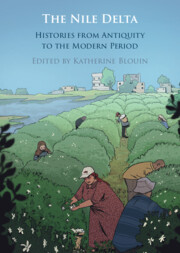Book contents
- The Nile Delta
- The Nile Delta
- Copyright page
- For Mona Abaza
- Contents
- Figures
- Maps
- Tables
- Contributors
- Acknowledgements
- Abbreviations
- 1 Introduction
- 2 Call Me by My Names
- 3 The Nile Delta before the Pharaohs
- 4 The Khetem-Border-Posts in the Delta during the New Kingdom
- 5 New Land amongst New Rivers?
- 6 The Mareotis Area
- 7 From Memphis to Alexandria
- 8 Growing with the Empire? From Village to Town
- 9 Mapping the Cult of Christian Saints in the Nile Delta from the Fifth to the Ninth Century CE
- 10 Alexandria
- 11 Imperial Power, Tribal Settlement and Fiscal Revolts in the Early Islamic Delta (Seventh to Ninth Century CE)
- 12 The Nile as Nexus
- 13 Water and Prices
- 14 Water Development in the Medieval Western Delta
- 15 The Nile Delta in European Cartography, 1200–1800
- 16 Just Passing Through?
- 17 Reclaiming the Archive
- 18 Short Commentary on Accounting Documents from a Vanishing Cotton Estate (ʿIzba) in the Nile Delta
- Index
- References
8 - Growing with the Empire? From Village to Town
Kom Abou Bellou and Its Urban Development
Published online by Cambridge University Press: 15 February 2024
- The Nile Delta
- The Nile Delta
- Copyright page
- For Mona Abaza
- Contents
- Figures
- Maps
- Tables
- Contributors
- Acknowledgements
- Abbreviations
- 1 Introduction
- 2 Call Me by My Names
- 3 The Nile Delta before the Pharaohs
- 4 The Khetem-Border-Posts in the Delta during the New Kingdom
- 5 New Land amongst New Rivers?
- 6 The Mareotis Area
- 7 From Memphis to Alexandria
- 8 Growing with the Empire? From Village to Town
- 9 Mapping the Cult of Christian Saints in the Nile Delta from the Fifth to the Ninth Century CE
- 10 Alexandria
- 11 Imperial Power, Tribal Settlement and Fiscal Revolts in the Early Islamic Delta (Seventh to Ninth Century CE)
- 12 The Nile as Nexus
- 13 Water and Prices
- 14 Water Development in the Medieval Western Delta
- 15 The Nile Delta in European Cartography, 1200–1800
- 16 Just Passing Through?
- 17 Reclaiming the Archive
- 18 Short Commentary on Accounting Documents from a Vanishing Cotton Estate (ʿIzba) in the Nile Delta
- Index
- References
Summary
Kom Abou Bellou is located halfway between Cairo and Alexandria, two kilometres west of the current Rosetta branch of the Nile. Despite early interest in the site and its good general state of conservation, it has remained largely ignored. Work undertaken in 2013 at Kom Abou Bellou reassesses our knowledge of the territory. The space, which includes the city, is considered over the long-term chronology to facilitate an analysis of the city and its space from the point of view of its internal organisation, its functions and its relation with its natural, political and socio-economic environment. The site has been occupied from the Old Kingdom until at least the tenth century CE. Diachronic study makes it possible to highlight the phenomena of creation, modification and appropriation of this space, notably the displacement of the settlement according to the periods and the reuse of previously occupied spaces. These transitions provide many examples that allow us to observe changes in the urban system and, more broadly, data on the land use patterns and the perception of space. This chapter aims to present the first reflections on this matter, which will be expanded as the archaeological site and its documentation are studied.
- Type
- Chapter
- Information
- The Nile DeltaHistories from Antiquity to the Modern Period, pp. 275 - 297Publisher: Cambridge University PressPrint publication year: 2024



